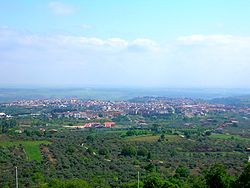Venosa
You can help expand this article with text translated from the corresponding article in Italian. (January 2022) Click [show] for important translation instructions.
|
Venosa | |
|---|---|
| Città di Venosa | |
 | |
St Felix of Thibiuca) | |
| Saint day | August 16 |
| Website | Official website |
Venosa (
History
Ancient
The city was known as Venusia ("City of
The town was taken by the
. No fewer than 20,000 men were sent there, owing to its military importance.Throughout the
It took part in the
Horace was born here in 65 BC. His father's estate in Venusia was confiscated by Augustus after his victory in the civil wars for the settlement of veterans, like many others throughout Italy.
It remained an important place under the Empire as a station on the
Middle Ages
After the fall of the
The Lombards made it a gastaldate in 570/590.
In 842 Venosa was sacked by the
Next rulers in the 9th century were the Byzantines, who lost control of it after their defeat in 1041 by the Normans. Under the latter, Venosa was assigned to Drogo of Hauteville. In 1133 the town was sacked and set on fire by Roger II of Sicily.
His later successor Frederick II had a castle built here where a Lombard outpost existed before, which was to house the Treasury (Ministry of Finances) of the Kingdom of Sicily.
Frederick's son,
Modern era
After a series of different feudal lords, Venosa became a possession of the
Then, under the
Despite the plague that had reduced its population from the 13,000 of 1503 to 6,000, Venosa had a flourishing cultural life under the Gesualdos: apart from the famous Carlo, other relevant figures of the period include the poet
Venosa took part in the
Home to a traditionally strong republican tradition, Venosa had a role in the peasant revolts and the Carbonari movement of the early 19th century.
A true civil war between baronial powers and supporters of the peasants' rights broke out in 1849, being harshly suppressed by the Neapolitan troops.(See
In 1861, after the fall of the
Main sights



- The Aragonese castle, built in 1470 by Pirro del Balzo Orsini. It has a square plan with four cylindrical towers. The shining sun, the del Balzo coat of arms, is visible on the western towers. It was turned into a residence by Carlo and Emanuele Gesualdo, who added also an internal loggia, the north-western wing and bastions used as prisons. From 1612 it was the seat of the Accademia dei Rinascenti. It is now home to the National Museum of Venosa, inaugurated in 1991, with ancient Roman and other findings up to the 9th century. The entrance is preceded by a fountain conceded by King Charles I of Anjou.
- Many fragments of Roman workmanship are built into the walls of the cathedral, which is due to Pirro del Balzo also (c. 1470).
- The Bohemund. An inscription on the wall commemorates the great Norman brothers William Iron Arm, Drogo, Humfrey and Robert Guiscard. The bones of these brothers rest together in a simple stone sarcophagus opposite the tomb of Alberada. The church also contains some 14th-century frescoes. Behind it is a larger church, which was begun for the Benedictines about 1150, from the designs of a French architect, in imitation of the Cluniac church at Paray-le-Monial, but never carried beyond the spring of the vaulting. The ancient amphitheatre adjacent furnished the materials for its walls.
- Baroque Church of the Purgatory (or San Filippo Neri)
- The Archaeological Area of Notarchirico, in the communal territory. It covers the Palaeolithic period with eleven layers dating from 600,000 to 300,000 years ago. Remains of ancient wildlife, including extinct species of elephants, bisons and rhinoceroses, have been found, as well as a fragment of a femur of Homo erectus.
- Jewish catacombs with inscriptions in Hebrew, Greek and Latin show the importance of the Jewish population here in the 4th and 5th centuries.[4]
- Remains of the ancient city walls and of an amphitheatre still exist, and a number of inscriptions have been found there.[4]
People
- Horace (65 BC – 8 BC): Roman poet
- Manfred (1232–1266): king of Sicily
- Bartolomeo Maranta (1500–1571): physician, botanist, and literary theorist
- Luigi Tansillo (1510–1568): poet
- Carlo Gesualdo (1566–1613): music composer, lutenist and nobleman
- Giovanni Battista de Luca (1614–1683): jurist and cardinal
- Giacomo Di Chirico (1844–1883): painter
- Mario de Bernardi (1893–1959): colonel and aviator
- Cinzia Giorgio (b. 1975): writer
Twin towns
References
- ^ "Superficie di Comuni Province e Regioni italiane al 9 ottobre 2011". Italian National Institute of Statistics. Retrieved 16 March 2019.
- ^ "Popolazione Residente al 1° Gennaio 2018". Italian National Institute of Statistics. Retrieved 16 March 2019.
- ^ "Basilicata" (in Italian). Retrieved 1 August 2023.
- ^ a b c One or more of the preceding sentences incorporates text from a publication now in the public domain: Chisholm, Hugh, ed. (1911). "Venusia". Encyclopædia Britannica. Vol. 27 (11th ed.). Cambridge University Press. p. 1014.


